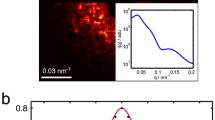Abstract
Fluctuations of the stored energy and emitted power of a semiconductor laser are derived by a simple model in which the light is considered as a classical particle flow. The fundamental noise source is the shot noise associated with field to absorbing or emitting atoms con-version. The mirror loss noise is taken into account in the form of a classical partition noise. For quiet pumping conditions the pump is no more a noisy process and a non- fluctuating optical output is possible. The theory allows the description of the intensity squeezed (i.e. non- classical) states of light and its results agree with quantum theory. Optimal conditions for squeezed state of light generation and characterization are pointed out.
Résumé
Les fluctuations de l’énergie stockée et de la puissance émise par un laser à semiconducteurs sont déterminées par un modèle simple traitant la lumière comme un flux de particules classiques. Le mécanisme fondamental de bruit est alors le caractère corpusculaire du rayonnement et sa manifestation lors de l’émission stimulée et absorption associée au milieu actif. Les fluctuations associées aux pertes par miwir(s) sont exprimées par un bruit de partition. Pour une pompe calme, les fluctuations associées au courant injecté sont négligeables et la puissance émise peut devenir non fluctuante. La théorie présentée permet également la description des états comprimés en intensité de la lumière (appelés aussi états non classiques) et de retrouver les résultats des théories quantiques. Les conditions optimales pour la génération et la caractérisation d’état comprimés de la lumière sont alors discutées.
Similar content being viewed by others
Bibliographie
Agrawal (G. P.), Dutta (N. K.). Long-wavelength semiconductor lasers.Van Nostrand Reinhold Compagny, New York (1986), Chapitre 6.
Machida (S.), Yamamoto (Y.), Itaya (Y.). Observation of amplitude squeezing in a constant current-driven semiconductor laser.Phys. Rev. Lett. (9 March 1989),58, no 10, pp. 1000–1004.
Richardson (W. H.), Shelby (R. M.). Non classical light from a semiconductor laser operating at 4 K.Phys. Rev. Lett. (22 Jan. 1990),64, no 4, pp. 400–403.
Kitching (J.), Yariv (A.), Shevy (Y.). Room temperature generation of amplitude squeezed light from a semiconductor laser with weak optical feedback.Phys. Rev. Lett. (24 Apr. 1995),74, no 17, pp. 3372–3376.
Inoue (S.), Machida (S.), Yamamoto (Y.), Ohzu (H.). Squeezing in an injection-locked semiconductor laser.Phys. Rev. A (3 Sep. 1993),48, no 3, pp. 2230–2234.
Freeman (M. J.), Wang (H.), Steel (D. G.), Craig (R.), Scifres (D. R.). Amplitude-squeezed light from quantum well lasers.Opt. Lett. (1 March 1993),18, no 5, pp. 379–381.
Freeman (M. J.), Wang (H.), Steel (D. G.), Craig (R.), Scifres (D. R.). Wavelength-tunable amplitude-squeezed light from a room-temperature quantum well laser.Opt. Lett. (15 Dec. 1993),18, no 24, pp. 2141–2143.
Henry (C. H.). Theory of the linewidth of semiconductors lasers.IEEE J. of Quantum Electron (1982),18, no 2, pp. 259–264.
Marcenac (D. D.), Carroll (J. E.). Quantum mechanical model for realistic Fabry-Perot laser.IEE Proc. J. (June 1993),140, no 3, pp. 157–171.
Arnaud (J.). Classical theory of laser noise.Optic. Quantum Electronics (Feb. 1995),27, no 2, pp. 63–89.
Loudon (R.), Knight (P. L.). Squeezed light.J. of Mod. Optics (1987),34, no 6/7, pp. 709–759.
Nilsson (B. O.). Noise mechanisms in laser diodes.IEEE Trans. ED (1994),41, no 11, pp. 2139–2150.
Yamamoto (Y.), Machida (S.), Nilsson (O.). Squeezed-state generation by semiconductor lasers. In: Coherence, amplification and quantum effects in semiconductor lasers.John Wiley & Sons, Y Yamamoto (1992), pp. 461–535.
Schimpe (R.). Intensity noise associated with the lasing mode of a (GaAl)As diode laser.IEEE J. QE (1983),19, no 6, pp. 895–897.
Joindot (I.). Bruit relatif d’intensité des lasers à semiconducteurs.Ann. Télécommun. (1991),46, no 3–4, pp. 191–204.
Vey (J. L.). Etude des états comprimés de la lumière générés par des lasers à semiconducteurs : applications aux télécommunications optiques.Thèse ENST 95022, Paris (1995).
Agrawal (G.P.). Effect of gain and index nonlinearities on single-mode dynamics in semiconductor lasers.IEEE J. QE (Nov. 1990),26, no 11, pp. 1901–1909.
Orsal (B.), Signoret (P.), Peransin (J. M.), Daulaim (K.), Alabreda (R.). Correlation between electrical and optical photocurrent noises in semiconductor laser diodes.IEEE Trans. ED (1994),41, no 11, pp. 2151–2161.
Tromborg (B.), Lassen (H.-E.), Olesen (H.). Traveling wave analysis of semiconductor lasers: modulation responses, mode stability and quantum mechanical treatment of noise spectra.IEEE J. QE (Apr. 1994),30, no 4, pp. 939–956.
Goodbar (E. F.), Ram (R. J.), Nagarajan (R.), Coldren (L. A.), Bowers (J. E.). Intensity noise and facet correlation in Fabry-Perot laser diodes with low facet reflectivities.Appl. Phys. Lett. (1995),66, no 25, pp. 3419–3421.
Vey (J. L.), Gallion (P.). Amplitude squeezing with a Fabry-Perot semiconductor laser with non linear gain: existence of an optimum biasing condition.Opt. Lett. (1st Oct. 1995),20, no 19, pp. 2018–2020.
Arnaud (J.). Photonic noise with non linear gain.Electron. Lett. (12th Sep. 1991),27, no 19, pp. 1756–1757.
Arnaud (J.). Amplitude squeezing from spectral-hole burning: a semiclassical theory.Phys. Rev. A (Sep. 1993),48, no 3, pp. 2235–2245.
Gallion (P.), Debarge (G.). Quantum phase noise and field correlation in single frequency semiconductor laser systems.IEEE J. QE (1984),20, no 4, pp. 343–349.
Machida (S.), Yamamoto (Y.). Observation of amplitude squeezing from semiconductor lasers by balanced direct detectors with a delay line.Optics Letters (1989),14, no 19, pp. 1045–1047.
Goodbar (E.). A Michelson interferometer with balanced detection for the characterisation of modulation and noise properties of a semiconductor lasers.IEEE J. QE (1993),20, no 4, pp. 1116–1147.
Author information
Authors and Affiliations
Corresponding author
Rights and permissions
About this article
Cite this article
Gallion, P., Vey, JL. & Jérémie, F. Classical optical corpuscular theory of semiconductor laser intensity squeezed-light generator. Ann. Télécommun. 52, 235–250 (1997). https://doi.org/10.1007/BF02996067
Received:
Accepted:
Issue Date:
DOI: https://doi.org/10.1007/BF02996067
Key words
- Semiconductor laser
- Background noise
- Quantum optics
- Particle radiation
- Light matter interaction
- Photon noise
- Noise source
- Shot noise
- Optical absorption
- Evolution equation




